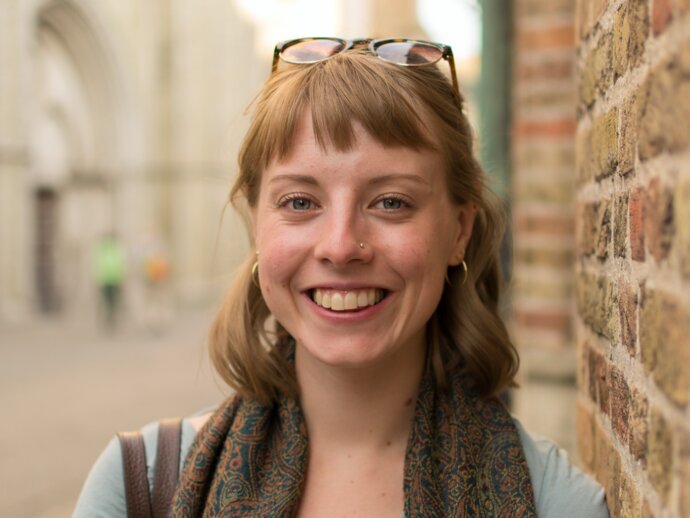Meet the Qualitative Researcher: Ceri McKay-Smith
Ceri is a linguistics PhD student at the School of Education, Communication & Society. She conducted qualitative research in a homeless shelter, examining homelessness in ‘discourse, narrative and interaction'. As part of her work she volunteered at a homelessness shelter and collected field notes, conducted interviews, and took recordings of routine events.
Sohail: Tell me a little about what you do and how you got into it?
Ceri: I got into linguistics and sociolinguistics doing my BA in modern languages. One third of my degree was English language. It is a bit awkward because people always ask you “what languages you speak?” The answer is none! I’ve actually forgotten the foreign languages side of it and have continued with linguistics.
During my masters in linguistics and English language, I had an option to do research in a workplace. I was in this meeting one day on potential placements. They were all for the typical jobs that you would try and gear English students towards; writing copy, managing social media feeds. None of the stuff I was interested in.
So, I felt quite disappointed and flicked to the back of the book. There was this advert saying: “linguist wanted, must be comfortable with despair, destruction and drug use” and I was like, okay, this sounds much more interesting. I went to this local homeless shelter and found it really interesting, and the environment was easy to work in.
Sohail: It sounds like you had good relationships with the people you work with, to get to the point where they are talking frankly with you about health problems. How did you build this?
Ceri: There were very few people I didn’t click with. Because I was going in once a week during the day, I was often seeing the same sort of type of resident. If people have serious drug habits, they are out during the day and they are only in the evening. So, I would see quieter residents. People who didn’t have serious drug habits, people who would stay in during the daytime.
Sometimes it was challenging, you can get a lot of extreme views. I think part of that is being let down by society so often. Conspiracy theories are quite popular, and people are quite anti-establishment. That side of it, I found quite hard. I was working as a volunteer as well. If you are trying to support someone it is hard to know how to challenge them, when that’s appropriate when that’s not.
A resident that I got on with really well with committed suicide early on. That shook me. I thought this is sort of really heavy stuff with big consequences. And I did go through a period when I was thinking “what on earth is the point of research? What am I doing, this isn’t going to help this person.” But then equally, I didn’t know quite what would have helped this person. I think research is valuable. But being in an environment when genuine life and death stuff is going on, it is hard. It was a wake-up call.
Sohail: How did you get through that?
Ceri: My supervisors were really good actually. I told them about it straight away. I was a bit like, don’t know what to do with this, but think you should know it happened. I had been sending them weekly research journal entries, so they knew who it was. I actually ended up gaving a LISS presentation on well-being from a researcher perspective. That was really helpful as I wrote it into something positive. I advocated for taking time off, making sure you’re okay and that you have avenues for letting out what you need to let out.
Sohail: In our emails you mentioned that you were careful not to paint shelter staff as the bad guys. Could you tell me a bit more about this?
Ceri: In literature I’ve read so far, when you are looking at inherent power imbalances and you care about the social group, it can lead to an assumption that people are always being taken advantage of. Then if you find a staff member who, the way they word things isn’t brilliant, or they evict someone for a reason I would disagree with, it is very easy to see them as a wrong.
But I look much more at the system as a whole. So much of my literature review is contextualising policy in practice. Trying to understand that there is a limit to what staff can do. Even if they disagree with the system. So whenever I come across something that could be seen as problematic, I try and bear that in mind. That actually, on both sides, most people are doing the best with what they can. And the problem is above them. They show the fallout of the policy decisions we’ve taken. There isn’t a right or wrong person.
Sohail: Does your research try and target more systemic change?
Ceri: I suppose it might. I don’t know quite what it can suggest in terms of systems. I think that’s the problem with when something is systemic. How on earth do you even begin to come up with solutions? But it will highlight how the system is causing problems.
Some of it will be very practical. For example, in the majority of shelters people have to agree that they won’t use drugs on site and if they do they would get evicted. So, you sometimes get situations of people hiding acute medical needs that are drug related because they don’t want to ask for help. People getting blood clots in their legs and not wanting to tell staff because if they do they might get thrown out. But equally, if they have a blood clot they need urgent medical attention.
Sohail: So, what does your research suggest changing to improve people’s health?
Ceri: There is a growing body of research looking at housing first initiatives. Which is basically, rather than looking at changing the individual, changing their behaviour, then finding them a house. You put them in a house then you approach any change from within the house. They have got stability; they are somewhere secure. Then you confront any behaviours that need to be addressed. So, my research does support that view of things, because environments at homelessness shelters are too chaotic to suggest that someone who has been using for a number of years will be able to cut down. It’s not stable, it can be quite scary, so it’s not realistic.

